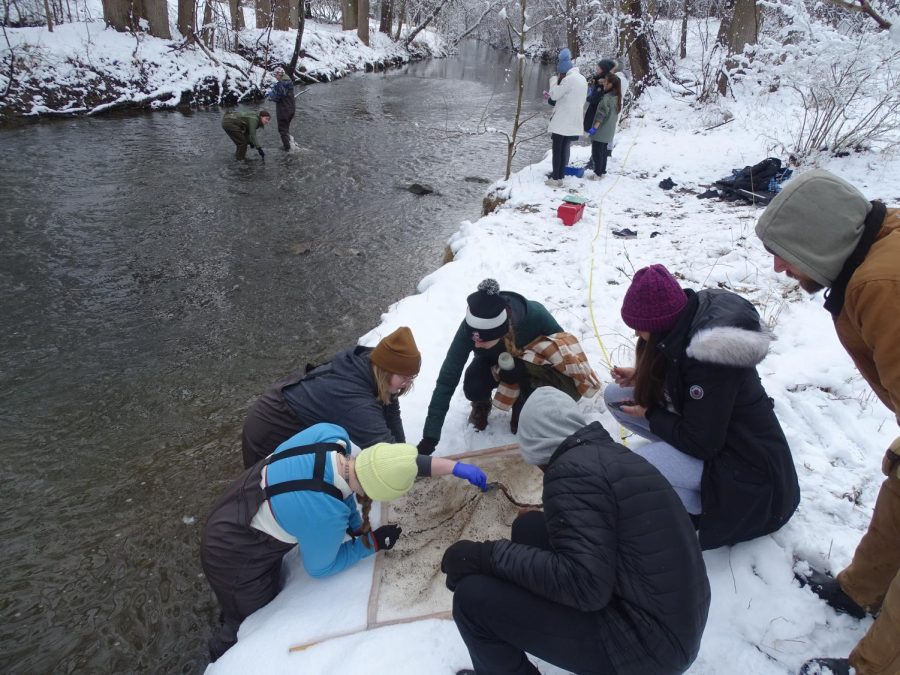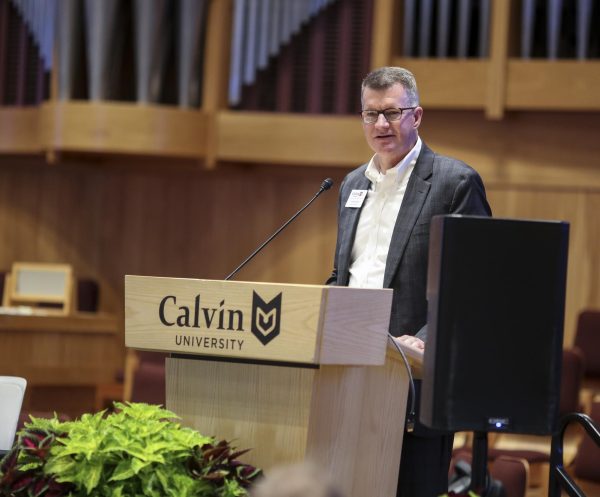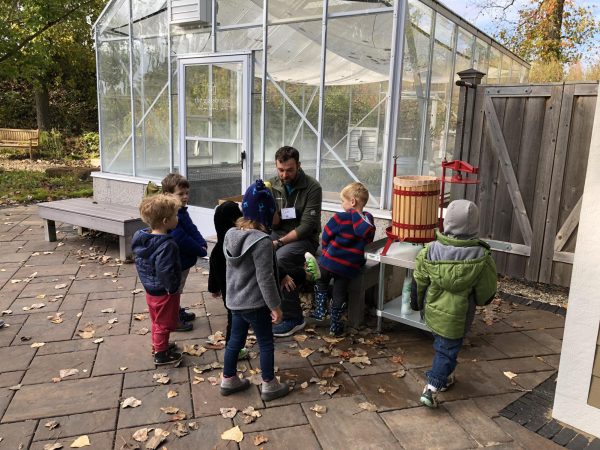What goes up(stream) must come down(stream): Calvin’s work to reduce impact on downstream communities via Plaster Creek
Biology Students conduct research on Plaster Creek as a part of class curriculum.
When rain falls and snow melts Plaster Creek surges in volume, causing a ripple of side effects. What flows into the water from Calvin’s campus has a direct impact on the health of the creek — and the communities downstream. There are several practices that the campus has implemented to mitigate harm, but the system still isn’t perfect. Calvin’s Plaster Creek Stewards work to continue reducing the university’s impact downstream.
Plaster Creek, a 14 mile long creek that runs south and east through Grand Rapids. The tributary is connected with many other tributaries flowing in from creeks around Grand Rapids. Plaster Creek passes through a variety of areas including industrial, agricultural, residential, and commercial locations. The river runs through low-income housing areas before joining the Grand River.
As the river moves downstream, problems arise. After rain falls or snow melts, the volume of water surgers —- referred to as “the trigger problem,” which acts as the catalyst causing several other problems.
“When stormwater run off increases it is bringing in stuff from the land that is not good for the creek or the downstream communities, so the E Coli [a dangerous bacteria], levels go really high,” Biology Professor Dave Warners said. Warners explained that the communities that are the most vulnerable for flooding are more susceptible to infection due to higher levels of E Coli in the water. There is also greater erosion in those areas. “All of the problems get exacerbated, concentrated as we move downstream. The people downstream are the ones most vulnerable,” he said.
E Coli can be very dangerous for children and people over the age of 65. According to the Center for Disease Control (CDC), most E Coli are harmless and part of a healthy intestinal tract. However, contaminated food or water may carry the types of E Coli that cause different illnesses through contact with animals or people. Some, however, cause some illnesses The prevention of this bacterial infection and other issues caused by the flooding of Plaster Creek is crucial for the health of the communities living downstream.
Calvin’s actions have a direct result on the health and safety of the communities downstream. All of Calvin’s runoff flows into Whiskey Creek, which is a direct tributary into Plaster Creek. “When we fertilize the lawn, when we salt the parking lots and roadways, that runoff goes off into Whiskey Creek and Whiskey Creek takes all that stuff and puts it into Plaster Creek,” Warners told Chimes. Fertilizer is commonly used on Calvin’s campus to maintain the expansive lawns.
Rain and snow do not naturally have this negative impact on Plaster Creek. “We have —-, collectively speaking, white european colonists have —- taken a forested landscape and we have basically cleared it and inserted roads and buildings and parking lots,” Warners said. Warners explained that after a rainfall, water would get trapped in trees, either evaporate or fall to the soil and get soaked up into the roots. This natural system efficiently worked to keep Plaster Creek from surging.
Calvin does not have the landscape to restrict storm water run off the way the Grand Rapids area used to be able to. However, the Plaster Creek Stewards, a Calvin group focused on restoring the health of Plaster Creek, are working together with the university to protect the Creek and the downstream communities.
Calvin is currently working on 10 projects to replace lawn space on campus with native foliage that will provide a more diverse ecosystem while also providing plants that can decrease the storm water runoff. “I don’t think there is any comparable college that has done anything like that. We are moving in a good direction,” said Warners.
There is a lot more lawn —- and even possibly excess parking lots —- on campus that could be converted into more environmentally friendly habitats. Warners strongly advocates for the addition of trees to campus. “Trees soak up so much water. A mature silver maple tree on average will soak up 500 gallons of water a day,” Warners said. Warners said that since the lawn spaces on campus don’t have enough trees, they don’t soak up the water the same way. Therefore, replacing some of the lawn space with trees and other native plants would provide benefits for Calvin’s campus and the downstream communities.
“What would it take for Calvin to become an organic, poison free campus,”Warners asked. Warners believes that it would take awareness, advocacy, a monetary commitment and commitment from the campus and its students.
Students have opportunities to help by joining the Plaster Creek Stewards or volunteering for other environmental sustainability groups on campus or in the Grand Rapids area.
“Looking around, this is your place as students for maybe four to five years. How do you want your place to be more environmentally friendly? Ask some questions, make some noise, get in some good trouble is what I like to say,” said Warners.








